
Photo: ESO/L. Calçada/M.Kornmesser | Wikimedia Commons
Black Holes continue to intrigue and thrill us because they are, as of now, the only object whose gravity, even light, cannot escape. This physics-defying nature of theirs makes them mysterious and captures our imagination as very few objects do. A black hole’s outer “surface,” called its event horizon, defines its boundary. If you cross the precipice of the event horizon, you are doomed to singularity– something that scientists haven’t been able to wrap their heads around.
But why do these oddities in spacetime exist in the first place? Yes, they are inevitable consequences of Einstein’s General Theory of Relativity. Any star that is massive enough to meet certain requirements would eventually form a Black Hole, as the dead stars would collapse under their own gravity. This is why “Black Holes” were known as “Gravitationally Collapsed Stars” in the beginning and was sometimes later called “frozen stars”, and finally came about the rather titillating term “black hole,” about which Stephen Hawking said:
“The new name caught on quickly. It suggested something dark and mysterious. But the French, being French, saw a more risqué meaning. For years, they resisted the name trou noir, claiming it was obscene. But that was a bit like trying to stand against le weekend, and other Franglais. In the end, they had to give in. Who can resist a name that is such a winner?”
Let’s examine the physical forces that led to the formation of the black hole to understand why they exist. While there are no myths related to the formation of black holes like the formation of the universe, there is some solid theoretical understanding of how black holes form.
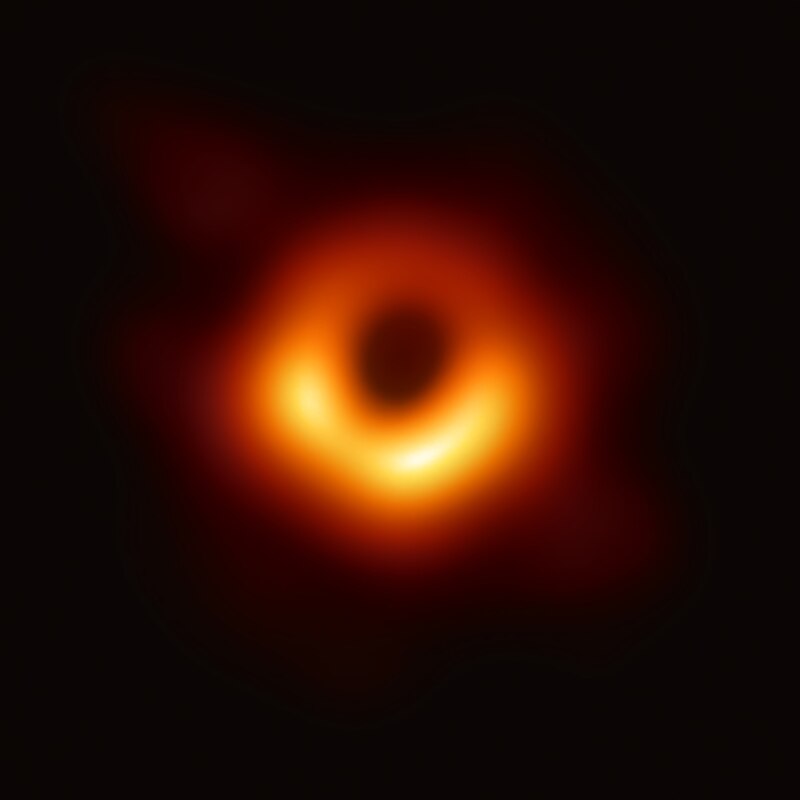
A picture of a Black Hole revealed by the Event Horizon Telescope
Initial Processes during the Formation of Black Holes
Black holes form from the life cycles of huge stars- ones that are comparably larger than our Sun. These massive stars produce energy in their core by the fusion of hydrogen into helium. This gives them outward pressure to balance gravity trying to collapse the star.
Eventually, the hydrogen runs out, as is the case with every other star. Then, there is no outward pressure to stop the star from collapsing under its own gravity. This can cause a super bright explosion called a supernova, which leads to a star’s outer parts getting thrown into space with a big boom. What remains is a dense and compact core.
Gravitational Collapse and Singularity
In the final act in the life cycle of a massive star, after having used up all its nuclear fuel, the star becomes lopsided with a disruption in the balance between the powerful pull of gravity and the counteracting fusion-generated outward pressure. Devoid of the outward pressure of fusion, the star sets off a dramatic gravitational collapse
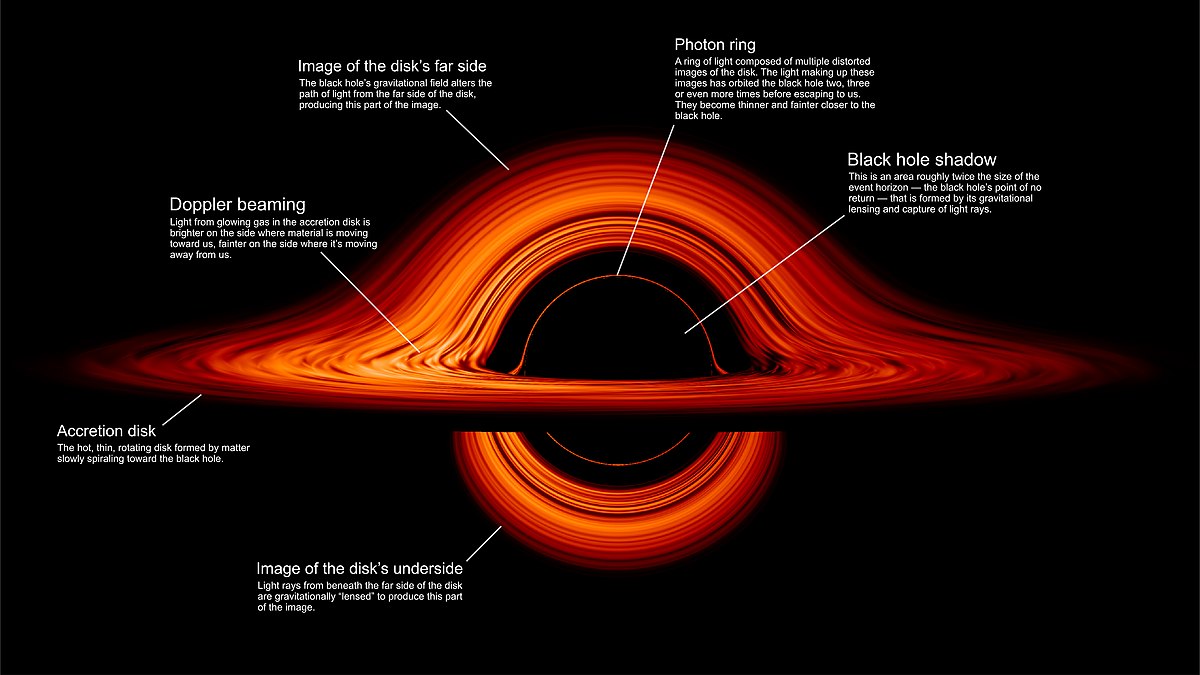
A star needs to meet specific criteria to transform into a black hole: the core has to be around three times or larger than the mass of the Sun. This necessary mass eventually leads to something we might shudder to call a “region” or “place” or “object” because the gravity becomes unimaginably/infinitely strong– to a value which we can’t associate with any “region,” “space,” “object” or “place” as we know yet. This infiniteness is called singularity and is encased by the event horizon. For the ones on the outside, an event horizon might be thought of as the start of a Black Hole, whereas from the perspective of someone inside the Black Hole, it denotes the outer limit of the black hole.
Such a singularity where spacetime curves infinitely and density unbounded is shielded from plain sight. This is due to what is known as a Cosmic Censorship Hypothesis that was put forward by Roger Penrose- the man who was awarded the Nobel Prize in physics in 2020.
What types of Black Holes exist?
Black holes can be, very broadly, generalized into three main types: stellar-mass black holes, supermassive black holes, and intermediate-mass black holes.
Stellar-mass Black Holes can have a mass comparable to relatively small-sized stars like the Sun – one of them, which is a mere 3-4 times the mass of the Sun, is a candidate for being the smallest Black Hole ever discovered. It is considered that such stellar mass Black Holes are abundant in the Milky Way- perhaps our galaxy harbors at least tens of millions of these.

An artist’s impression of a stellar-mass black hole in the spiral galaxy NGC 300.
The supermassive ones have a different composition altogether, as they weigh millions or billions of times more than the Sun. They are housed in the middle of galaxies, like our Milky Way. One of the possible ways of formation of these supermassive Black Holes was by accreting lots of stuff over a long time or by the merger of many black holes. There is evidence that a billion solar mass Black Hole had formed 12 billion years ago, and finding the answer to the formation of such a Black Hole so far into the past is
Stephen Hawking, in his essay “Einstein’s Dreams,” posits that there might be another class of Black Holes which would fall in neither of the categories discussed above:
“But there might be very much smaller black holes, which were formed in the early universe. These primordial black holes could be less than the size of the nucleus of an atom, yet their mass could be a billion tons, the mass of Mount Fuji. They could be emitting as much energy as a large power station.”
He also comments that such primordial black holes might have evaporated as of now:
“On the other hand, a primordial black hole should have almost completely evaporated in the ten billion years that have elapsed since the Big Bang, the beginning of the universe as we know it. Such black holes should now be emitting hard gamma rays with an energy of about 100 million electron volts.“
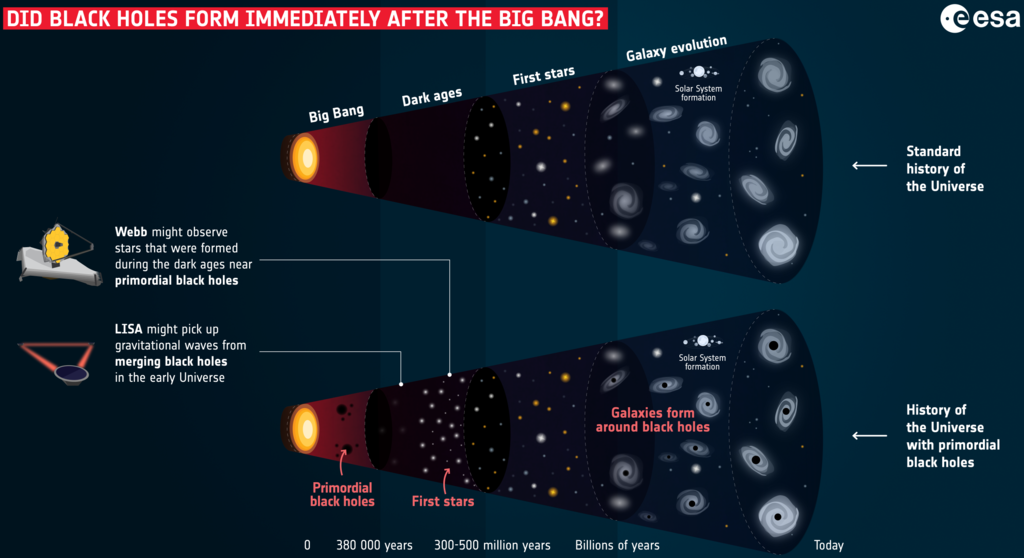
Formation of the universe without (above) and with (below) primordial black holes
Theoretical Framework of a Black Hole
Tolman–Oppenheimer–Volkoff limit
After a star sheds the skin of its outermost surface in a supernova explosion, there is no radiation pressure to balance the enormous pull of gravity of the particles that remain. But these remnants don’t get crushed by the weight of their own gravity, as a force called neutron degeneracy pressure pushes back. This force helps to prevent a neutron star from entirely collapsing.
But if a neutron star is heavier than a certain size, even the neutron degeneracy pressure is not strong enough to ward off the gravitational collapse. Tolman–Oppenheimer–Volkoff limit(TOV) is a scientific concept that deals with the maximum mass a stable neutron star can have before collapsing into a black hole due to the force of gravity..
Ergosphere
The ergosphere is a region outside the event horizon of a rotating black hole where the black hole’s rotational energy is transferred to the surrounding space, i.e., the spinning hole drags the space-time around it with it. Even light traveling against the rotation direction will be carried backward around the hole. This peculiarity is called the “frame-dragging effect.” If something is dropped in this region, it will start orbiting the hole like objects around a tornado.
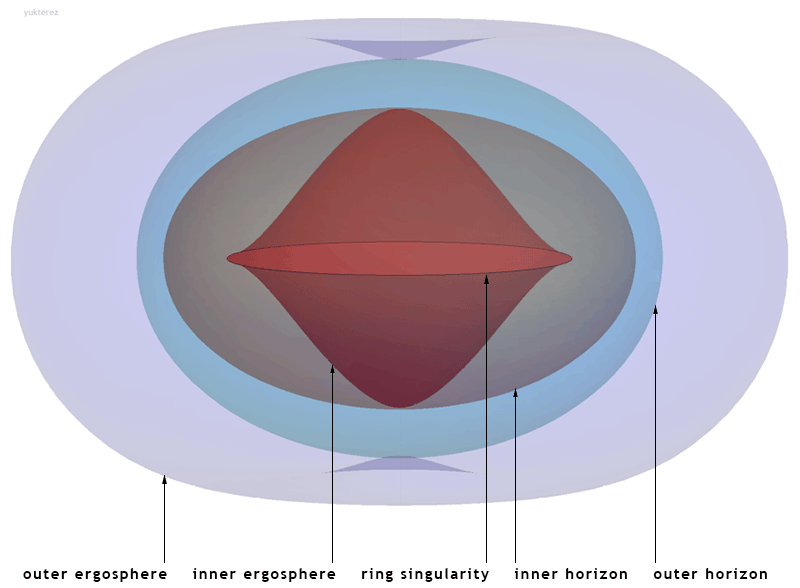
Photon Sphere
A photon sphere is a region in space around a black hole where light particles, called photons, can orbit the object in a circular path. Now, what’s interesting is that this happens because of the intense gravity near a black hole. Gravity is like a giant invisible hand that bends the path of light, and when a photon gets close enough to a black hole without falling in, it can get trapped in orbit. Light goes round and round, but it never actually crosses the finish line into the black hole.
Physical properties: charge, mass and spin
The physical properties of black holes, mostly mass and spin, are said to be the key to understanding everything there is to know about black holes. One Black Hole differs from any other in these 3 fundamental respects. This is one of the reasons why John Wheeler came up with his precis: “Black Holes have no hair.”
Evidence and Observations
How was the picture of a Black Hole Taken?
Eight radio telescopes scattered across the globe (from Hawaii to Antarctica) merged to form the Event Horizon Telescope (EHT). This telescope observed two supermassive black holes millions of light-years away from Earth. The obtained images were of a black hole at the center of Milky Way galaxy Sagittarius A* and M87*. The M87 is located at the center of the galaxy Messier 87, roughly 55 million light-years away from Earth, with a mass 6.5 billion times that of our Sun.
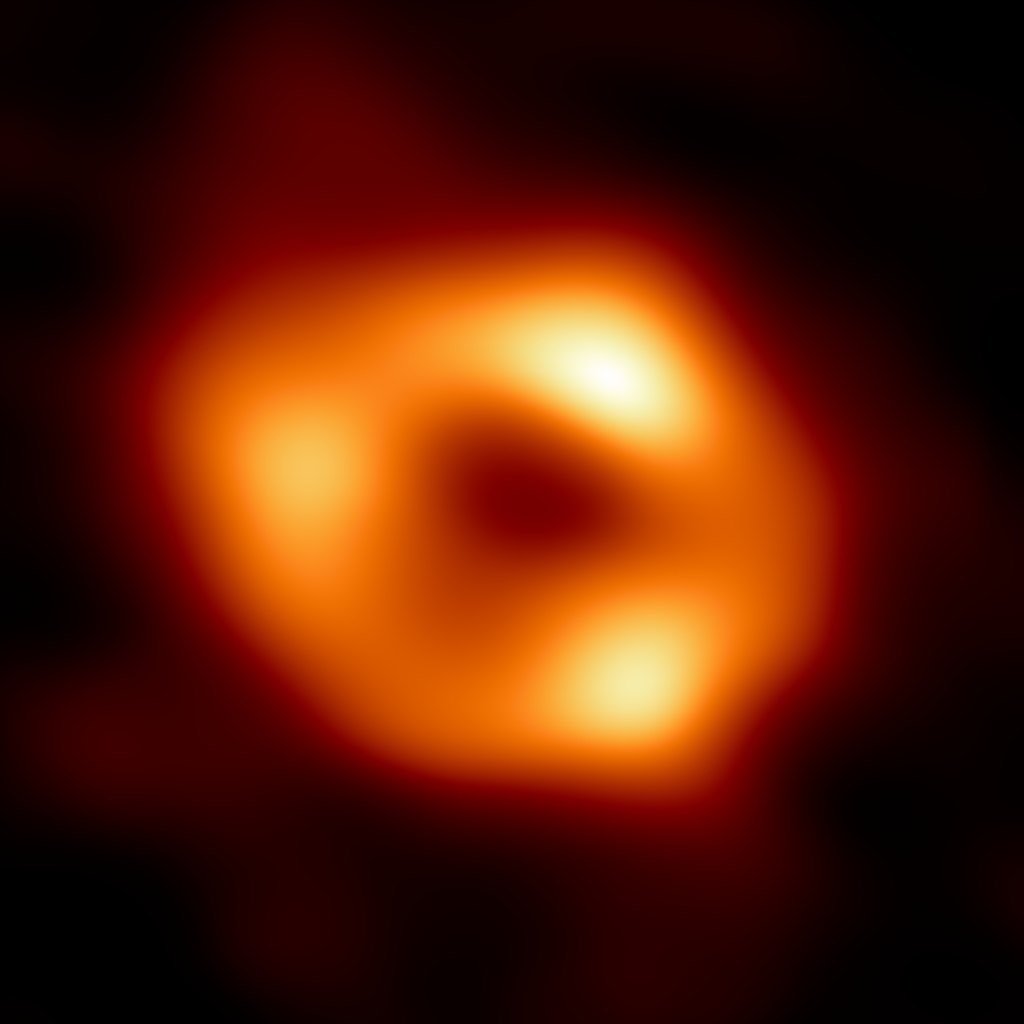
This is the first image of Sgr A*, the supermassive black hole at the centre of our galaxy.
How does the study of Accretion disc help us study Black Holes better?
The accretion disc plays a crucial role in black hole formation. This disk of gas and dust surrounds a massive object, such as a black hole or a protostar. When matter falls towards an object because of gravity, it collides with other particles, gaining momentum, heating up the disc, and releasing radiation. Because it supplies the fuel required for the black hole to expand, the accretion disc is an essential part of the black hole development process. Most of the black holes we’ve identified in the Universe have been through the high-energy effects of their accretion disks.
Other Observational/ Inferential ways that point toward a Black Hole
A key proof of the presence of a Black Hole is the discovery of gravitational waves. Teams at the Laser Interferometer Gravitational-Wave Observatory (LIGO) and Virgo have spotted spacetime waves made by black hole pairs merging. So, this direct evidence confirms black holes for real.
Aside from gravity waves, scientists have spotted how black holes impact matter nearby. A binary system’s black hole, for example, might make its star partner emit X-rays due to its strong gravitational pull. This provides strong but indirect proof of the black hole being there.

LIGO Livingston Observatory
Role of Black Holes in the Universe
Black holes, with their extraordinary size and influence, have a tight grip on how galaxies grow and behave. This is because they alter where the stars and gas are spread. These stretches of gas eventually form interstellar/ intergalactic matter, which in turn are building blocks of new stars and galaxies.
When stuff is guzzled by supermassive black holes (or any Black Hole in particular), these monsters release huge amounts of energy, either in the form of jets spurted from accretion discs that form around it or from the violence of the matter that it is eating away at.
It was the merger of Black Holes that helped us confirm Einstein’s prediction of gravitational waves. On an ironic note, Einstein wasn’t particularly enamored by the implications of his equations that necessitated the formation of a Black Hole and went to great depths to write a paper discarding such a notion.
Conclusion
Looking into black holes is as much about unlocking the puzzle pieces, cracking a code of the cosmic order fo the universe. We know that without gravity, our universe just doesn’t work- even our Earth is held just perfectly in space by the forces of gravity- the most predominant of which is with regards to the Sun. Most say that the center of a Balck Hole houses a singularity, somewhere gravity, space, and time breaks down- much in the sense that numbers break down at infinity. Despite it all, Black Holes have a certain charm to them. Jana Levin, the wonderful writer of “Black Hole Survival Guide” impeccably puts it:
“Black holes are a gift, both physically and theoretically. They are detectable on the farthest reaches of the observable universe. They anchor galaxies, providing a center for our own galactic pinwheel and possibly every other island of stars. And theoretically, they provide a laboratory for the exploration of the farthest reaches of the mind. Black holes are the ideal fantasy scape on which to play out thought experiments that target the core truths about the cosmos.”
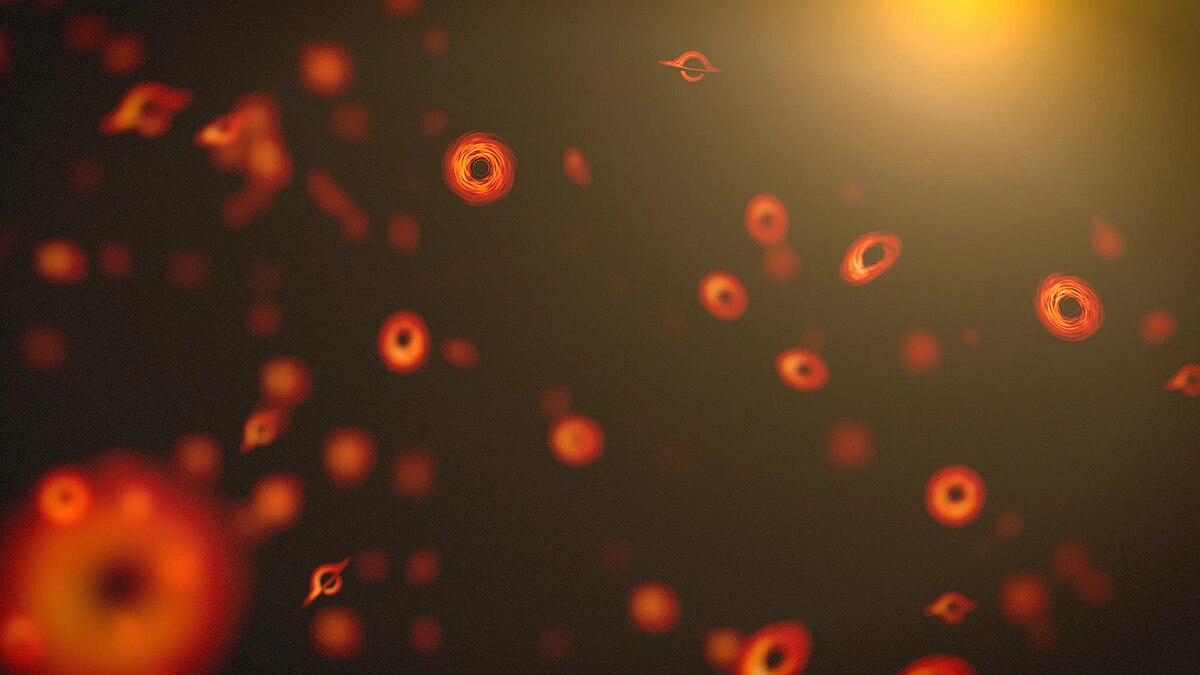
Photo: NASA’s Goddard Space Flight Center | Wikimedia Commons
FAQ’s
What is the purpose of a black hole?
Black holes influence the evolution of galaxies and contribute to our understanding of fundamental physics. Their micro-level roles are to recycle cosmological debris, stabilize the formation of galaxies, define their shape, and stratify space around them. Their macro role is a subsystem in the preservation of the Universal balance, construct, and shape.
Given that our understanding of a Black Hole is far from complete, what other purposes it serves is soemthing that will be revealed more in the future.
Does time exist in a black hole?
Black holes’ incredibly powerful gravitational field, which affects space-time, causes them to display time dilations, and extreme ones at that. So, black holes have time because of this time dilation effect.
Where does a black hole take you?
Physicists Ahmed Almheiri, Donald Marolf, Joseph Polchinski, and James Sully proposed the AMPS firewall or the black hole firewall hypothesis. According to their estimates, quantum mechanics could theoretically transform the event horizon into a massive wall of fire, causing everything in its path to burn instantly. So, the AMPS firewall theory posits that a black hole doesn’t take you anywhere because nothing can ever get inside it. But other theories might point in different directions.
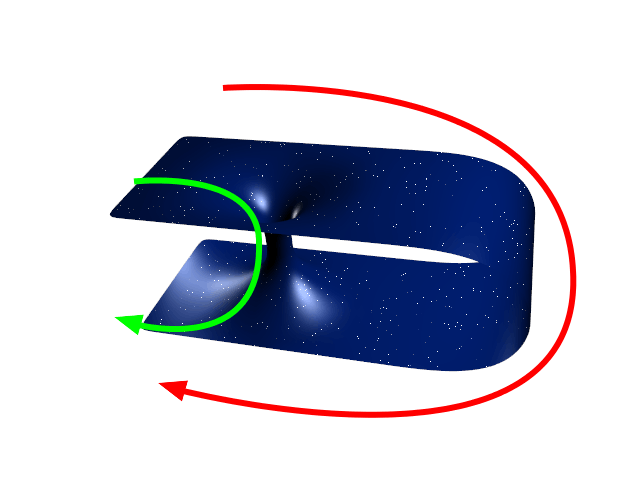
Two regions which we would normally traverse along the red curve can be connected by a wormhole, along the short-cut (the green curve)
Is a black hole a wormhole?
Wormholes and black holes are two different things. A wormhole is a hypothetical spacetime tunnel that might link far-off places. However, a black hole is an area subject to strong gravitational pull, any object passing through the event horizon is burnt. Thus, black holes aren’t wormholes.
How many black holes are there in the universe?
According to scientific theories, 150 billion stars are thought to originate annually, or roughly 275 million stars every day. Many of these stars also pass away every day. When stars die, they either transform into white dwarfs or neutron stars or if their mass is high enough, they can form black holes. Scientists say that our universe contains roughly 40 quintillion black holes. It is highly challenging to estimate the precise number of black holes that could exist in the universe.
Is information lost in a black hole?
Stephen Hawking, in 1976, stated that information can neither be emitted from a black hole nor be preserved inside forever. However, recent discovery says that information cannot be erased due to the laws of quantum physics. Researchers discovered that information might be carried out on Hawking radiation by incorporating quantum gravity into Hawking’s initial computations.
How close can you get to a Black Hole?
Approaching a black hole involves extreme gravitational forces. Crossing the event horizon is a point of no return, leading to the inevitable infall toward the singularity.
How long do black holes last?
A size black hole about a few times more massive than the sun will take about 10^100 years to eventually evaporate through this process. Hawking radiation proves this statement theoretically.
